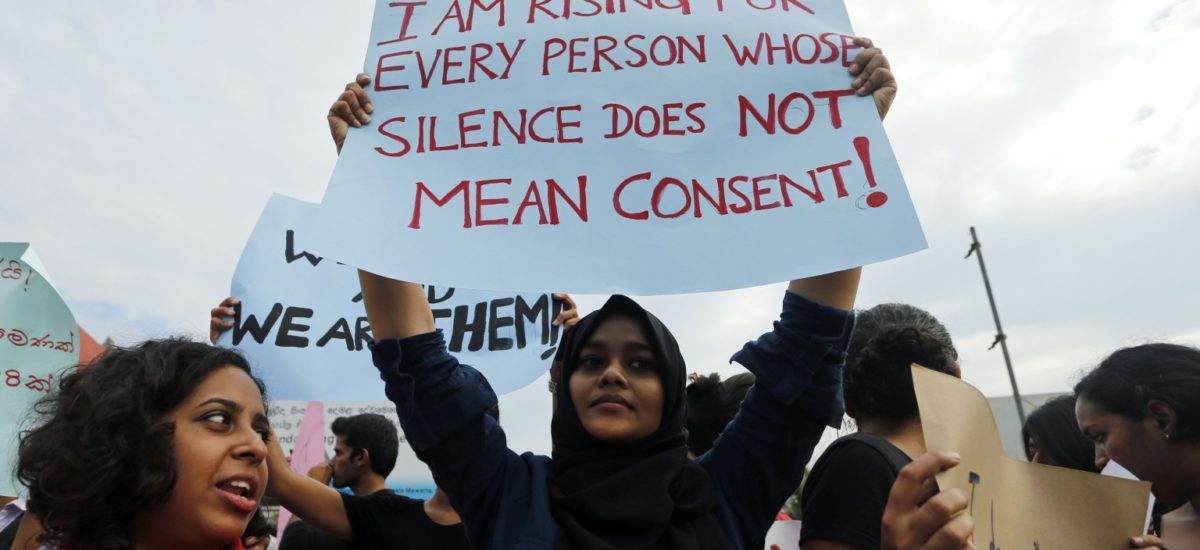Sri Lankan women hold placards during a demonstration to mark “One Billion Rising” campaign called to bring an end to violence against women, on Valentines Day in Colombo, Sri Lanka, Thursday, Feb. 14, 2013. Rights groups demanded the government take action to curb rising rape, domestic violence and gender base attacks on Sri Lankan women. (AP Photo/Eranga Jayawardena)
The recent sexual assault of tourists in Mirissa has made headlines but the only unusual aspect of the incident was that it received substantial media attention: Sri Lanka has a national pandemic of sexual violence.
Both foreign and Sri Lankan women and girls are targeted throughout the country, and the incidents are often much more brutal than Mirissa. For example, within the last two years alone, the media has reported gang rapes in Kandy, Colombo, Anuradhapura, Badulla, Hambantota, Trincomalee and Matara. Perpetrators included military police, a monk, a hotel owner, teenagers, construction workers and camp counselors. Victims’ ages ranged from six to 47. Yet none of these incidents received the same level of media coverage or government response as the incident in Mirissa.
Sexual violence occurs throughout the world, but the frequency of sexual violence in Sri Lanka is extraordinary. Sri Lanka’s Legal Aid Commission found that Sri Lanka has the highest rate of sexual harassment in South Asia, and South/East Asia has the second highest rate of gender-based violence worldwide. Ina 2013 UN study, one out of three Sri Lankan men (33%) admitted that they had carried out at least one act of physical or sexual violence against a woman.
On A Personal Level
I’ve lived in Sri Lanka on-and-off for the past decade. During the “off” times, I’ve lived in countries in Africa, the Middle East, and Europe. I’ve never experienced anything even approaching the level of sexual harassment that I’ve experienced in Sri Lanka.
In Colombo, a man broke into my apartment at 3:00 am- not to steal anything, but to wake me up and then expose himself.
Trishaw drivers have attempted to assault me on multiple occasions. In one case, another trishaw driver saw me trying to flee, and came to pick me up. When my would-be assaulter began following us, the second trishaw driver insisted that we drive to the nearest police station. Four police officers came to the front counter to “help” me. All four laughed in response to my story, as if I had just told them a joke. One said, “What do you expect? You’re a woman.” Then, to my surprise, the first trishaw driver sauntered into the station. He complained to the police that I hadn’t paid him for the ride. In response, the police told me that if I didn’t pay him I would have to “stay with them” in the police station. I then paid the man who had tried to attack me. This is why the women rarely report incidents to the police.
In another instance, a Department of Immigration official told me that if I didn’t have sex with him, he would revoke my visa and have me deported.
An ice cream truck once followed me through Trincomalee town, with the driver shouting, “Hey baby, get in the truck.” The whole time, it was playing the typical ice cream truck music that is designed to attract children.
I’ve experienced near-constant street harassment in Badulla, Kandy and Unawatuna.
Like the vast majority of women in Sri Lanka, I’ve been groped, grabbed and felt up on public buses.
Despite these experiences, I am lucky. I have heard much worse stories from both foreigners and Sri Lankan women, including serial rapes and being sexually assaulted as a child.
Impact
The impact of the sexual violence epidemic has serious consequences not only for the victims, but for Sri Lanka’s national welfare.
The government is responding to Mirissa incident because it fears that such assaults could negatively impact the tourist industry and the economy. But it’s not only incidents against tourists that have financial costs. Violence against women results in estimated global economic losses of 1.2 trillion US dollars per year because of the “direct cost of the health system, counseling and other related services, the justice system, child and welfare support, as well as indirect costs, such as lost wages, productivity and potential.”
Additionally, a 2012 study found that “the very best predictor of a state’s peacefulness is not its level of wealth, its level of democracy, or its ethno-religious identity…[it’s] how well its women are treated.” In the aftermath of the Kandy riots, this phenomenon may be particularly relevant in Sri Lanka.
And, of course, sexual violence has severe consequences for victims. It is strongly associated with suicide attempts and increased rates of depression worldwide, and that linkage is present in Sri Lanka as well.
Exceptional Impunity
Despite the severity of the problem, perpetrators of sexual violence in Sri Lanka enjoy almost complete impunity. The aforementioned UN study found that only 3% of rapists in Sri Lanka were arrested, the lowest proportion amongst the seven Asian countries in the study. 2036 rapes were reported in 2016, but not a single rapist was convicted.Even the few offenders who serve jail time are sometimes given sentences below the legal the minimum.
Solutions
In order to combat sexual violence in Sri Lanka, perpetrators must face not only face legal repercussions, but social consequences as well. The government has an obligation to increase legal accountability, but society must also play a role in addressing the problem. Peer pressure has been shown to be one of the most effective ways to achieve social change. Perpetrators don’t usually see women as their peers. It is therefore other Sri Lankan men –- the majority of whom are not perpetrators –- who have a great deal of power to combat the problem. They must consistently make it clear to their friends and colleagues that sexual violence is not normal, not respectable and not acceptable.

